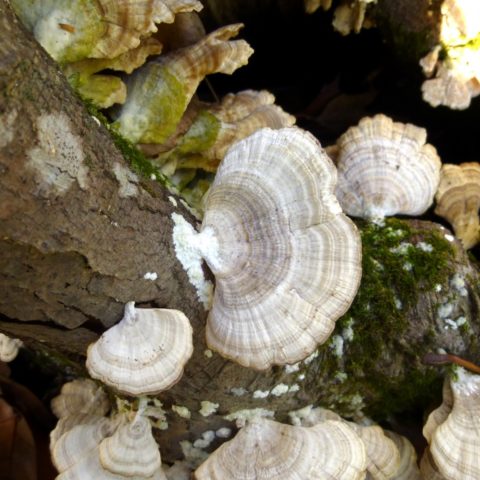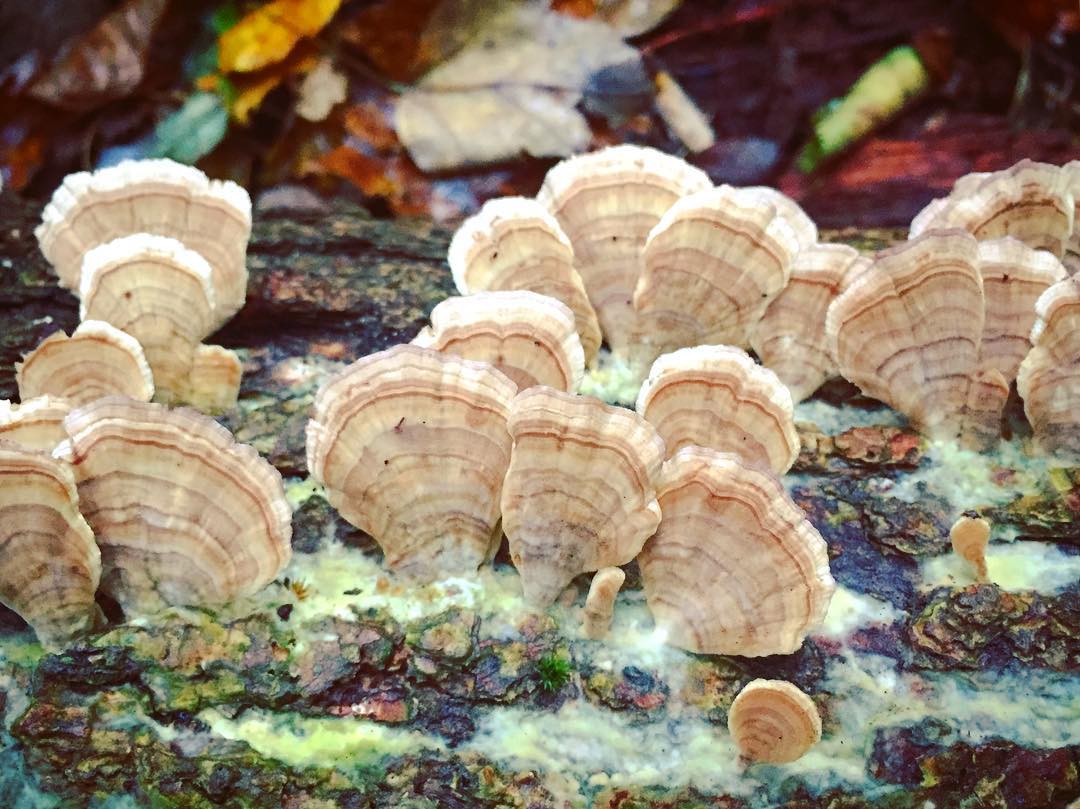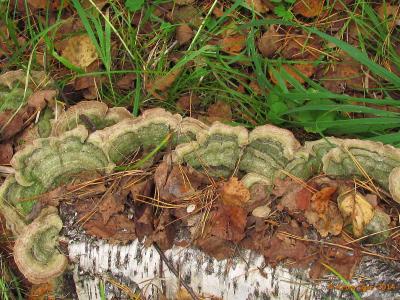Cerrena monochromatic: photo and description
Cerrena unicolor is known under the Latin name Cerrena unicolor. Mushroom from the Polyporovye family, genus Cerren.

The species forms dense, numerous groups of fruiting bodies.
What does cerrena monochromatic look like?
The fungus has a one-year biological cycle, less often fruiting bodies are preserved until the beginning of the next growing season. Old specimens are stiff and fragile. The main color is gray, not monotonous with weakly expressed concentric zones of a brown or brown hue. On the edge, the seal is in the form of a beige or whitish color.
External characteristic of cerrene monochromatic:
- The shape of the fruit bodies is semicircular fan-shaped, outstretched with wavy edges, narrowed at the base.
- The cap is thin, up to 8-10 cm in diameter, sedentary, tiled. Mushrooms densely growing at one level, accrete with lateral parts.
- The surface is bumpy, densely covered with fine pile; closer to the base, areas are often found under moss.
- The hymenophore is tubular, weakly porous at the beginning of the growing season, then partially destroyed, becomes dissected, serrated with an inclination towards the base. Large oval cells are arranged in a labyrinth.
- The color of the spore-bearing layer is creamy with a gray or brown tint.
- The pulp is tough corky, consists of two layers, the upper leathery is separated from the lower by a black thin stripe. The color is beige or light yellow.

Radial stripes are concentrated in the upper part of the fruiting body
Where and how it grows
Common cerrene is widespread in the European part, the North Caucasus, Siberia, and the Urals. The species is not tied to a specific climatic zone. The fungus is a saprophyte parasite on the remains of deciduous trees. Prefers open areas, forest clearings, roadsides, ravines. Fruiting - from June to late autumn.
Is the mushroom edible or not
Cerrene monochromatic does not represent nutritional value due to its tough pulp and pungent odor. In mycological reference books, it is assigned to the group of inedible mushrooms.
Doubles and their differences
To a greater or lesser extent, Cerrene monochromatic is similar to the varieties of Coriolis. More similar in appearance is the covered trametez, especially at the beginning of development. The twin is inedible with thick-walled pores and pale ash coloration. Odorless mushroom and black stripes between the layers.

The stripes are dark gray, occasionally with a yellowish tinge, the edges are sharp and light brown
Conclusion
Cerrene monochromatic - tubular appearance with a pungent spicy odor. The representative is annual, growing on decaying remains of deciduous wood. The growing season is from early summer to late autumn, does not represent nutritional value.
Description

Pore surface magnified
Cerrena unicolor has fruit bodies that are semicircular, wavy brackets up to 10 centimeters (4 in) wide. Attached to the growing surface without a stalk (sessile), the upper surface is finely hairy, white to grayish brown in color, and in zonate — marked with zones or concentric bands of color. The surface is often green from algal growth. The pore surface is whitish in young specimens, later turning gray in maturity. The arrangement of the pores resembles a maze of slots; the tubes may extend to 4 mm deep. The spore print is white.
When a female wasp of the genus Tremex bores into wood near these fungi, spores will become trapped in the wasp’s ovipositor. The spores are carried with the wasp’s eggs and will eventually germinate where the eggs are placed. As the spores germinate and form a mycelium, the wasp’s eggs will hatch, and the newly-born larvae eat the mycelium. The wasp species Tremex columba requires C. Unicolor to grow, as without the interaction, the larvae will die. However, after these eggs are laid, the parasitic wasp genus Megarhyssa will lay its own eggs within the eggs of the Tremex wasp. The larvae of Megarhyssa, when hatched, proceeds to eat the larvae of Tremex, helping control the population of Tremex.
Spores are elliptical in shape, smooth, hyaline, inamyloid, and have dimensions of 5–7 by 2.5–4 µm.
References
- ^
- Bulliard, J.B.F. (1789). Herbier de la France (in French). 9... pp. 385-432.
- Murrill, W.A. (1903). A historical review of the genera of the Polyporaceae. Journal of Mycology. 9 (2): 87–102.
- ^
- Kuo, Michael; Methven, Andy (2010). 100 Cool Mushrooms... University of Michigan Regional. p. 43. ISBN.
- ^
- Zhishu, Bi; Guoyang, Zheng; Li, Taihui (1993). The Macrofungus Flora of China's Guangdong Province... Chinese University Press. p. 209. ISBN 978-962-201-556-2.
- Phillips, Roger (2010). Mushrooms and Other Fungi of North America... Buffalo, NY: Firefly Books. p. 315. ISBN 978-1-55407-651-2.
- Leonowicz A, Gianfreda L, Rogalski J, Jaszek M, Luterek J, Wojtaś-Wasilewska M, Malarczyk E, Dawidowicz A, Fink-Boots M, Ginalska G, Staszczak M, Cho N-S. (1997). "Appearance of laccase in wood-rotting fungi and its inducibility." Journal of Korean Wood Science and Technology 25: 29–36.
- Rogalski J, Dawidowicz A, Jóźwik E, Leonowicz A. (1999). Immobilization of laccase from Cerrena unicolor on controlled porosity glass. Journal of Molecular Catalysis (B: Enzymatic) 6: 29–39.
Scientists' discovery points to the effectiveness of Cerrena unicolor in the fight against cancer

For many years, thousands of people have been fighting cancer, and scientists are still looking for an effective drug to fight the "killer" of the 21st century.
Researchers from the Department of Biology and Biotechnology of the University of Maria Curie-Sklodowska went a step further in search, who discovered that the well-known fungus that is responsible for the death of trees can be very helpful in the fight against cancer.

Cancer drug based on the fungus Cerrena unicolor
Cerrene monochromatic is an unremarkable mushroom that is considered a tormentor of trees and their roots. It can be found almost everywhere.And, probably, no one would have thought that a tree parasite could defeat human diseases. Fortunately, they were interested in researchers from the University of Marie Curie-Sklodowska.
The discovery of Polish scientists is a significant step for the development of oncology. It provides a chance for the ultimate victory in the fight against cancer. Previously, monochromatic cerrene was used mainly in industry: it was added in the production of paints and dyes. Now it has been possible to study its properties from a biomedicine angle.
According to the assurances of scientists, in the near future, a drug will be created that will help fight cancer. At the same time, they note that the biggest problem is the transition from one stage of research to the next. This requires funds that, unfortunately, they do not have.
Equally important is the responsibility of scientists for the words spoken, because one can easily communicate to the whole world that a cure has been found that will cure cancer and, thus, give hope to many people suffering from cancer.
The main character is lacaza
Researchers claim that an enzyme, lacase, isolated from the fungus Cerrena unicolor, acts on individual cancer cells.
The next stages of the study will have to confirm the effect of substances on tumor cells in living organisms. Scientists confirm that preliminary research offers great hope.
Researchers report that lacase acts only on tumor cells without affecting healthy tissue. This is the biggest success!
The enzyme worked best on cervical cancer cells, but it also showed positive effects in the fight against melanoma and blood cancer. In addition to its antitumor effect, lacase also exhibits antiviral properties.
Cerrena unicolor: how it looks, where and how it grows, edible or not

Cerrene monochromatic (Cerrena unicolor) INEDIBLE
Fruit body. 5-8 (10) cm wide, semicircular, sessile, adherent sideways, sometimes narrowed at the base, thin, felt on top, concentrically furrowed, with weak zones, first grayish, then gray-brownish, gray-ocher, sometimes dark at the base, almost black or green with moss, with a lighter, sometimes whitish, wavy edge. Tubular layer. First medium-porous, then dissected, with elongated, characteristically sinuous pores, inclined towards the base, grayish, gray-cream, gray-brownish. Pulp. First leathery, then hard, corky, separated from the upper felt layer by a thin black stripe, whitish or yellowish, with a pungent spicy odor. The spore powder is whitish. Beneficial features. This particular mushroom turned out to be the most promising for medicine. According to the research results, the greatest antitumor activity is possessed by monochromatic cerrene. The mechanism of action of the mushroom extract is to stimulate the immune system. Mushroom properties, markedly increase the production of B-lymphocytes and antibodies. Thus, the immune system actively resists cancer. In addition, an increased blood content of cytokines with anti-inflammatory properties is noted; these substances also make a significant contribution to increasing the body's resistance.
GROWING INSTRUCTIONS
Wood preparation. Hardwood trees are felled after the leaves fall and before bud break. Tree trunks with a diameter of 15-20cm. sawn into cuts 1m long. and put in a woodpile in a shady place. Before inoculation, freshly cut wood should be aged for about 2 months. Immediately before planting, the trunks are sawn into 15-20 cm long cuts.
Inoculation. Holes with a diameter of 10-15 mm are drilled in the cuts. and a depth of 30-60mm. then they fill them with mycelium of the fungus, and on top they cover the hole with a thin layer of paraffin or wax.
Garden bed device. A trench 1m wide is dug in the ground. and a depth of 15cm. arbitrary length. Then, in the trench, the cuts are carefully placed in two rows at the same level. The distance between the rows is 40-50cm, and between the cuts in a row is 5-7cm. The free space in the trench is covered with good fertile soil up to the upper edge of the timber. On top of the cut, the mulching material is poured with a layer of 2-3 cm. (sawdust, straw, etc.). If the soil is cold, then the trench is covered from above with a film, building a kind of greenhouse.
Maintaining a microclimate. During the growth of the mycelium in the bed, it is necessary to maintain a high temperature (20-26 ° C).
Fruiting. Fruiting bodies are usually formed one year after inoculation. For fruiting, a sufficiently high air humidity (70-85%) and a temperature in the range of 18-26 ° C are required. Usually the stump bears fruit once.
Consumption rate: one package of mycelium is enough for 30KG wood.
Substrate components. Currently, as a rule, a mixture of sawdust and chips (1: 1) of deciduous trees is used. To increase the yield, 5-15% of cereal bran is added to the main substrate, but no more. Then the mixture is soaked in a molasses solution (0.2%) for 3-4 days and fermented at room temperature.
Substrate preparation. The prepared substrate with a moisture content of up to 60% is placed in polypropylene bags 20 by 40 cm. and sterilized for 2 hours in hot water.
Inoculation. The inoculum is introduced into the substrate in compliance with the rules of sterility in the amount of 2%. After inoculation, the bags are transferred to a dark room and placed on racks.
Mycelium growth in the substrate. In the chamber, where the substrate fouling occurs, it is necessary to maintain the temperature within the range of 22-27 ° C. Gas exchange takes place through cotton-gauze plugs that close the bags or vessels. As a rule, complete colonization of the substrate occurs 20-30 days after sowing.
Fruiting. In a room with a temperature of 20-22 ° C, fruiting begins in 30-40 days. After removing the upper part of the bags, the CO2 level drops sharply and the formation of a hat begins, which requires a lighting level of 75-100 lux. It is also necessary to maintain a high humidity level of 90-95%, otherwise fruiting bodies will not form.
Harvesting. In the first wave of fruiting, the yield is usually 6-10% of the mass of the substrate, in the second 2-4%. The fruiting cycle of all phases usually takes 3-4 months.
Consumption rate: 2% of the total mass of the prepared substrate
Cerrena unicolor - Cerrena unicolor
| Cerrena unicolor |
|---|
| Scientific classification |
| Kingdom: |
| Synonyms |
|
Cerrena unicolor commonly known as mossy maze polypore , is one of a species of poroid fungus of the genus B Cerrena (Family: Polyporaceae). This saprobic fungus causes white rot.
taxonomy
The mushroom was originally described by the French botanist Jean Bulliard in 1785 as Boletus UNICOLOR when all the mushrooms were sweating, usually assigned to the genus boletus ... William Alphonso Murrill passed it on Cerrena in 1903. the fungus acquired long and extensive synonyms, as it was redescribed under various names, and was passed on by many tinder fungus genera.
Description
Cerrena unicolor has fruiting bodies that are semicircular, undulating braces up to 10 cm (4 in) wide. When applied to a growing surface without a stem (rocky), the upper surface is finely hairy, from white to grayish brown, and in a zoned star with zones or concentric stripes of color. The surface is often green from algae growth. The pore surface is whitish in juveniles, then turned gray at maturity. The arrangement of the pores resembles a maze of slots; pipes can run up to 4 mm deep. Dispute print white.
The spores are elliptical, smooth, hyaline, inamyloid, and have a size of 5-7 from 2.5-4 microns.
ecology
Cerrena unicolor causes ulcers rot and decay in paper birch ( paper birch ) and sugar maple ( Acer sugar ). The mushroom is widespread and is found in Asia, Europe, South America and North America.
Applications
Cerrena unicolor has been identified as a source of the laccase enzyme. This enzyme has potential applications in a wide variety of bioprocesses. S. Unicolor it is known to produce laccase in culture under more favorable conditions and with a higher yield than other rotting fungi wood, and research focuses on methods of producing laccase economically on a large scale.
























































